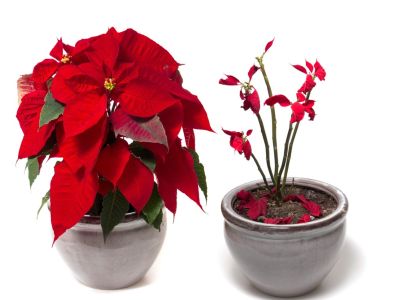The holidays find stores filled with goodies and things to purchase. One thing, plants, should make it into our consumer baskets too. Poinsettias are brightly colored with many variations available. The variegation, striping, speckling, and other patterns of the leaves are joined by hues of red, cream, gold, pink, and green. These natives of Central America are not winter hardy, but make perfect houseplants. Their color and patterns bring in a lively aspect to our holiday appointments. They are also relatively easy to grow, but occasionally a poinsettia is dropping leaves. It is important to find out why in order to save these holiday classics.
Why is My Poinsettia Dropping Leaves?
Even the best gardener with the most vigorous green thumb will have some difficulty with their plants. Each plant has unique cultivation requirements. Lighting, soil type, moisture levels, and heat tolerance will vary greatly by species. In the case of poinsettias, they are native to regions that see warm temperatures year-round, and rarely get severe cold. They are locally called Flor de la Noche Buena, or Flower of the Holy Night. They develop the “flowers” during winter which coincides with the holiday season. The flowers aren’t really flowers, but bracts or secondary leaves. The true flowers are insignificant and tiny, not the focus of the plant. The true leaves which are normally green, and the colorful bracts comprise the plants.
What to Do If a Poinsettia is Losing Green Leaves
Poinsettias were introduced to the U.S. in the early 1800s by Joel Poinsett, Ambassador to Mexico at the time. The true leaves are generally green. They will be present year-round. As the daylight hours diminish, the plant will be encouraged to produce beautiful bracts. To do this, the plant needs exposure to shorter, winter daylight hours. It must also be in relatively warm temperatures. One reason the plant may drop leaves is exposure to temperature variations. If the plant is near a drafty door or window, it will express its displeasure by dropping leaves. Move such a plant to the home interior where it will be kept warm and not experience cool breezes or drafts. In spring, when temperatures outdoors warm up, the a poinsettia may be grown outdoors.
Poinsettia Bracts Falling Off
It is always disappointing if the “flower” part of the plant is failing. Really, this is the reason we purchase the poinsettia, for its bright color. In order to stop foliar fail, consider its water levels. Too much water is a stress for the plant, as is high humidity. It is important to remove the foil wrapper when watering the plant. Failure to do so will trap excess moisture and can cause leaf drop due to root rot. The biggest culprit is too little water. Although their native region doesn’t receive very much rain, these plants do need regular moisture, especially when in containers. The moisture level should be even as measured by inserting a finger deeply into the soil. Avoid setting the plant in a saucer that will be filled with extra water. Let the plant drain freely after watering to prevent any fungal or bacterial issues.
